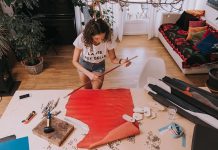Fixing sewing machine problems is no laughing matter, especially when yours stops working during an important project. But if you’re familiar with the nuts and bolts of a sewing machine and related tools, you stay worry-free. The two most common cases of a broken sewing machine are due to a sewing machine needle breaking, or having your thread bunching up in your fabric, making a huge mess of your project. Fabric is an important tool for anyone who regularly uses a machine, you don’t want to mess it up. If you think you broke your machine, check again. It could be something else.
Whether it’s cotton, denim, or fleece that you’re sewing, anyone can easily experience some technical difficulties with their machine.
Other problems consist of your sewing machine thread bunching on the bottom of fabric and your bobbin thread bunching up. Fixing these issues can be intimidating, bet rest assured, fixing sewing machine problems is easy if you have the proper guide! So let’s get started on fixing sewing machine problems.
Needle Breaking Problem:

If your needle broke and you don’t know what to do, you’re in the right place. A broken needle will stop your sewing machine dead in its tracks. It’s important to note why this may happen to address the problems that are causing the break, otherwise, you may get the idea that it is your sewing machine that is broke and not your needle. That, however, isn’t always the case.
Incorrectly using your thread may often lead to breaking a needle. If you don’t thread the needle properly, your machine may show some serious difficulties when it comes to performance. If your thread is not properly secured on the spool pin, you may also face some serious difficulties. Threading should be done carefully and with caution. Fixing these problems can be achieved by simply looking up a basic guide as to how these specific actions should be performed to produce the highest quality of work.
You could be using the wrong needle, as there are many, and if yours broke, we have a helpful guide as to which ones are available. Typically, there are seven different types of needle; the ballpoint, quilting point, regular point (sharp), wedge point, embroidery needles, universal point needles, and topstitching needles. Each type of needle serves a different purpose, and many of them use different threads. Keep that in mind while trying to fix your sewing machines. If this goes unnoticed, it may serve as a problem far longer than you’d want it to.
Your needle may also not be properly inserted. This can lead to inaccurate stitching and many other issues, including breaking your needle altogether. Ensure that the needle is properly aligned on the sewing machine and secured tightly. This is imperative. Another common issue is a bent or damaged needle, leading to crooked stitching. You may also have a built-up bobbin. Too much lint in your bobbin can cause your machine to halt entirely and/or operate in a very loud manner. Always remember to regularly clean your machine.
Sewing over pins is much faster than taking them all out before sewing, but this can be a large risk to your machine. Often, hitting another needle will break the one you’re using. This will render your sewing machine useless until it can be repaired. Take the extra time to make sure you remove all your pins, otherwise, you may end up with some costly repair bills.
When it comes to breaking needles, only one other topic stands out. That topic, is needle position. Not having your needle properly aligned and centered can lead to stitching going where you never intended it to go. Ensure that you properly installed the needle. To double-check, I advise consulting your owner’s manual, so you know you’re doing it right.
How to Fix Needle Breaks:

To lower the risk of needle breaks, remember to ask yourself if you’re using the right needle for the job you’re trying to perform. Sizes range greatly, so trying different sizes up and down may help.
The higher the needle size, the thicker the fabric it is meant for. Lower needle sizes are used for fabrics like cotton. Remember, though, it isn’t just about size. Remember those types of needles we discussed earlier? Keep them in mind.
Try avoiding sewing over other pins, that can be catastrophic to your machine. Ensure that you’re properly utilizing your threads and cleaning out your machine regularly as well.
Make sure to check your owner’s manual for helpful information as to how to secure and position your needle. Don’t forget to check for bent or broken needles as well!
Thread Bunching Problem:

Bird nesting is a term used when your thread starts bunching up into a ball that resembles a bird’s nest. This can be a major hassle in the world of sewing and there are a select few possible causes. Many think the bobbin is the cause of their bird nesting or thread build up, but it does happen due to other issues as well. The bunching of threads can make any enthusiast frustrated, so take your time trying to fix the issue.
One of the causes is the fact that commonly, the thread has not been threaded through each guide on it’s way to the needle, allowing too much slack build-up. You must make sure that the bobbin is threaded properly as well. If the bobbin case tension is too loose, you’ll end up with the thread going from top to bottom until it’s a tangled mess.
Always make sure to thread your machine with the presser foot up, otherwise, the thread won’t be able to set properly. This can also cause bird nesting. Make sure you clean your machine, too!
It’s not only all over your machine and fabric that may end up a tangled wreck, make sure to keep an eye on the bottom of your fabric and machine, as there are some causes for this as well. Once again, you may have incorrectly threaded the bobbin. Make sure you always thread your machine with the presser foot up, putting it down every time; if you don’t, this is the cause of your bird nesting. When the foot is down, tension is given, allowing the thread to flow through the machine and cotton, (or whatever fabric you’re using), very easily.
Another common cause for sewing machine thread bunching on the bottom of the fabric is an uncleaned machine. I stated earlier how important it is to clean your machine. They collect dust and shards of thread. This is inevitable, so make sure you’re checking the cleanliness of your machine. Cleaning makes it so you won’t end up fixing your sewing machine in the end.
How to Fix Bunching Problem:

Ensure that the entirety of your machine is thoroughly cleaned. Make sure your pressure foot is up while threading, and down while sewing.
Check your owner’s manual to ensure that the machine and bobbin are both properly threaded and installed. Your issue may be as simple as a tension dial that was turned too tight accidentally.
Tips:
- Clean your sewing machine lightly on a regular basis
- Ensure that you’re using the proper needle type and size
- Avoid stitching over pins as this can badly damage your needle
- Check your owner’s manual for instructions and guides as to how to operate and properly perform maintenance on your machine
- Check your tension setting and threading accuracy
Wrapping it Up
In a lot of situations, a perfectly good sewing machine ends up trashed because the user doesn’t think it can be fixed. This, however, is not always the case. Double check this guide to make sure you’re not wasting a perfectly good household utility. There are other guides and tips sites available online, If you are still having any issues, I suggest taking a look at those as well. Fixing sewing machine problems is easy. Just keep your head in the game, take proper care of it, and oil it regularly.
 Home
Home Sewing, Embroidery & Serger
Sewing, Embroidery & Serger Cutting machines
Cutting machines Brands
Brands Review
Review






































